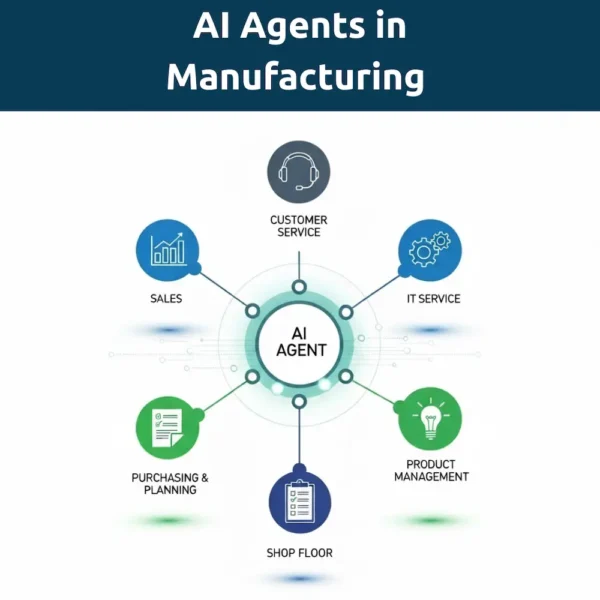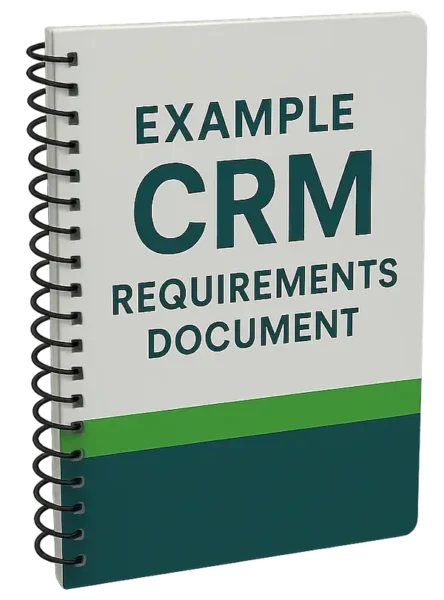Cutting Through the Noise
AI is everywhere in the headlines. Depending on what you read, it’s either going to save manufacturing or put half the workforce out of a job. The truth is less dramatic but far more useful: AI is a practical tool manufacturers can start using today.
At CRM Switch, we’ve seen manufacturers both large and small use AI agents to solve real problems without huge budgets or multi-year projects. This isn’t about using ChatGPT to write emails or create images. Manufacturers are applying AI agents directly to their business—driving measurable improvements in sales, service, and operations. They’re everyday solutions helping leaders forecast demand more accurately, cut supply chain costs, and give service teams better tools to keep customers happy.

If you’re an executive, IT leader, sales leader, service leader, operations manager, or product manager, AI isn’t some abstract concept. It’s a tool that can improve your team’s performance right now. And when combined with the CRM you already rely on, it becomes even more powerful.
What Are AI Agents? (In Plain English)
AI agents are software programs that can act on their own, learn from data, and make decisions in real time. Unlike traditional automation, which follows fixed rules, AI agents adapt to changing conditions. They can manage workflows across systems, identify trends in customer behavior, and trigger the right actions without waiting for someone to push a button.
Why Manufacturers Should Care Now
- Affordable to Start: You don’t need a massive investment or a team of data scientists to get value. Easy-to-use AI tools are available today that can act directly on your existing customer data.
- Quick to Deploy: Many projects deliver measurable results in weeks, not years.
- Strategic Advantage: The global AI-agent market is forecast to grow from $3.66B in 2023 to $139.12B by 2033—a 43.9% annual growth rate (Miquido). Companies that start now will outpace competitors who wait.
What AI Agents Mean for Different Leaders
For Executives
Executives want results that show up on the bottom line. AI agents are delivering. A Deloitte survey found that 79% of organizations that adopted AI reported measurable cost savings or efficiency gains. The bigger story: those who start now build an early advantage. From reducing procurement spend to making better use of assets, AI agents can translate directly into profitability and strategic advantage.
For IT Leaders
AI-Enhanced IT Service Management
We have seen IT service teams burdened by a backlog of incidents, repetitive tickets, and escalating service requests. Too often, support staff spend more time firefighting than driving improvement.
AI agents can now transform IT service management by:
- Automating routine requests such as password resets, access provisioning, or status checks frees staff from repetitive tasks.
- Deflecting incidents through intelligent self-service, offering users the requested information or accurate next steps before a ticket is even logged.
- Prioritizing and routing issues based on context—sending critical outages directly to the right resolver group, while low-priority issues are queued appropriately.
- Surfacing insights from patterns in tickets and alerts, helping IT leaders spot recurring problems and address root causes before they spiral.
Real-World Example
In one manufacturer, repeated login failures on plant-floor workstations created constant support tickets. An AI agent identified the pattern, traced it to an expired integration between the MES and Active Directory, and automatically routed the alert to the right IT group. Instead of wasting hours resetting individual accounts, the IT team fixed the root cause—and the flood of tickets stopped overnight.
Outcome:
- Faster resolution and reduced escalations
- Fewer tickets clog the queue
- IT staff are free to focus on strategic initiatives
- A shift from reactive support to proactive, preventive service
For Sales Leaders
Sharper Forecasting and Smarter Selling
Sales leaders need forecasts they can trust. In many organizations, forecasts are still based on gut feel, static reports, or inconsistent CRM entries. An AI agent changes that.
AI agents now continuously analyze order history, customer buying patterns, open opportunities in CRM, and seasonal demand cycles. When it sees a shift—say, customers ordering earlier than usual or a drop-off in orders—it updates the forecast automatically and highlights risks and opportunities for the sales team.
For individual reps, the agent surfaces the “next best action” directly inside CRM: which leads are most likely to close, which quotes need follow-up, and which customers may be at risk of attrition. It can even recommend bundling options or promotions based on what similar customers have purchased.
The outcome is a forecast that sales leaders can take to the executive team with confidence, and a sales force that spends more time closing deals and less time chasing bad leads.
Visibility into Manufacturers’ Rep Performance
Many manufacturers rely on independent reps. According to Deloitte, manufacturers that rely heavily on independent reps face major visibility challenges, with over 60% citing limited insight into territory performance. It’s hard to know which reps are high performers, which territories are underperforming, and which end customers are being ignored.
An AI agent changes that dynamic. By analyzing CRM opportunity data, order history, and customer activity by geography, the system can surface insights into rep performance that were previously hidden. For example, it can highlight that a territory with steady market demand is currently lagging in new orders—pointing to a rep who may not be fully engaged. Or it can identify regions where new customer inquiries are growing but not being followed up on.
For sales leaders, this means less guesswork when evaluating rep performance and more objective data to guide conversations, incentives, and territory adjustments. The result: improved market coverage and stronger alignment between representatives and the manufacturer’s goals.
For Customer Service Leaders
Smarter Request Handling and Faster Resolutions
Too often, customer requests bounce between departments or sit unresolved because it’s unclear who should handle them. By 2026, AI bots will handle 20% of all customer service interactions (Gartner), showing just how quickly this shift is happening.
An AI agent streamlines the process. When a customer reaches out—through email, chat, or another channel—the agent analyzes the request in real time. If it’s routine, such as checking order status or warranty information, the AI provides the requested information or accurate next steps immediately, often deflecting the need for a phone call. If the request points to a potential product quality concern, the agent routes it directly to the quality or engineering team for follow-up. And if it involves billing, chargebacks, or invoicing, it’s automatically sent to finance.
The agent also enriches every request with context from the CRM—purchase history, past interactions, and contract terms. This allows frontline agents to engage with the full picture instead of asking the customer to repeat themselves.
Outcome:
- Faster response times without adding headcount
- Fewer misrouted requests
- Service teams are spending less time triaging and more time solving problems
- Customers who feel heard and valued because their issues are resolved quickly and correctly
For Purchasing and Planning Leaders
Smarter Inventory and Demand Planning
We have seen purchasing and planning teams move away from static spreadsheets and last year’s averages by leaning on AI agents. These agents continuously analyze sales orders, seasonality, supplier performance, and even external factors such as shipping delays. Distributors using AI have cut inventory levels by 20–30% and logistics costs by 5–20% (McKinsey), showing the scale of improvement that’s possible.
When a shift occurs—such as demand softening for one product line or a supplier falling behind—the system adjusts inventory recommendations automatically and alerts planners. It suggests reorder points, safety stock levels, and production schedules in real time. If excess inventory starts to build, it pinpoints the cause, whether it’s over-ordering or a sudden change in customer demand.
Outcome:
- Leaner inventory and lower carrying costs
- More accurate purchase orders and production schedules
- Fewer surprises for planning teams
- A supply chain that reacts to market changes in real time
For Product Managers
Early Product Issue Detection and Market Insight
We have seen product managers benefit in two powerful ways. First, AI agents can analyze customer interactions across CRM, service tickets, and digital channels to identify trending wants and needs. That intelligence helps shape the roadmap with products that match what the market actually demands.
Second, those same feedback loops surface product or quality issues early. For example, if multiple service tickets point to failures tied to a specific production lot, the AI agent can lock down the related inventory and trigger a non-conformance process. Engineering is alerted to investigate, while finance is looped in for potential chargebacks. This closes the loop faster and prevents widespread issues from hitting more customers.
A Practical Starting Point
AI agents are not a future technology. They are already helping manufacturers work smarter—whether that’s cutting inventory waste, improving sales forecasts, or giving service teams faster insights. The barrier to entry is much lower than many leaders think. You don’t need a massive budget or a team of data scientists to see results. The key is starting with a focused use case, building on systems you already have in place.
If you’re ready to explore where AI agents could make the biggest difference in your business, let’s have a conversation. We’ll help you identify practical opportunities and create a roadmap that delivers results quickly.



